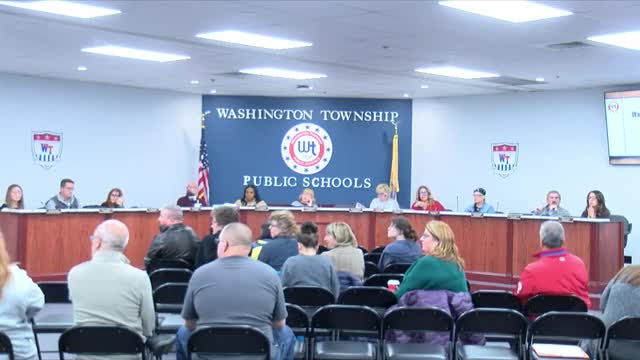Washington Township reports gains on 2024–25 state assessments; science remains a challenge
October 29, 2025 | Washington Township School District, School Districts, New Jersey
This article was created by AI summarizing key points discussed. AI makes mistakes, so for full details and context, please refer to the video of the full meeting. Please report any errors so we can fix them. Report an error »

Gretchen Gerber, a district staff member, told the board the district’s 2024–25 New Jersey Student Learning Assessment results showed ‘‘in ELA, we are higher than the state in all grade levels,’’ and highlighted a roughly 19‑percentage‑point advantage over the state in fifth‑grade ELA.
Gerber said the district’s algebra and high‑school mathematics pathways complicate comparisons with the state because students take different assessments (algebra I, geometry, algebra II) depending on course placement. ‘‘Some of them take the algebra assessment,’’ she said, and ‘‘geometry is about 60 of our students’’ in high school, making small cohorts more volatile in percentage terms.
The presentation also covered the graduation proficiency assessment (GPA) for 11th graders. Gerber reported Washington Township’s 11th‑grade ELA graduation‑ready rate at 86.4% versus a state figure of about 80%, and math graduation‑ready at 60.2% versus a state figure near 58%.
Gerber described subgroup trends by race, free‑and‑reduced‑price‑lunch status, special education and ELL status, saying some subgroups show steady year‑over‑year improvement. On the ACCESS test for English‑language learners she said many elementary ELLs remain in the developing band but the district sees growth, and that three ELL teachers service the district population.
On math, Gerber called the results ‘‘work in progress’’ but said the district is narrowing gaps with new curriculum supports, a new supervisor, professional development and digital tools including iReady, ALEKS and IXL. She said science is ‘‘problematic throughout the state’’ and noted that the science assessment’s cyclical coverage of content increases difficulty for 11th‑grade test takers who are assessed on multiple years of science coursework.
Gerber closed with district strategies: continuing interventions in ELA and math, targeted professional development on the new adaptive NJSLA format, use of diagnostic/prescriptive digital platforms, and an emphasis on small‑group instruction and data analysis.
District leaders thanked staff and the board for the work that supported gains; board members also noted the district’s expansion of pre‑K and credited that early support as a possible factor in stronger lower‑grade outcomes.
The presentation did not include a formal board action; board members asked for and received a district copy of the slide material.
Gerber said the district’s algebra and high‑school mathematics pathways complicate comparisons with the state because students take different assessments (algebra I, geometry, algebra II) depending on course placement. ‘‘Some of them take the algebra assessment,’’ she said, and ‘‘geometry is about 60 of our students’’ in high school, making small cohorts more volatile in percentage terms.
The presentation also covered the graduation proficiency assessment (GPA) for 11th graders. Gerber reported Washington Township’s 11th‑grade ELA graduation‑ready rate at 86.4% versus a state figure of about 80%, and math graduation‑ready at 60.2% versus a state figure near 58%.
Gerber described subgroup trends by race, free‑and‑reduced‑price‑lunch status, special education and ELL status, saying some subgroups show steady year‑over‑year improvement. On the ACCESS test for English‑language learners she said many elementary ELLs remain in the developing band but the district sees growth, and that three ELL teachers service the district population.
On math, Gerber called the results ‘‘work in progress’’ but said the district is narrowing gaps with new curriculum supports, a new supervisor, professional development and digital tools including iReady, ALEKS and IXL. She said science is ‘‘problematic throughout the state’’ and noted that the science assessment’s cyclical coverage of content increases difficulty for 11th‑grade test takers who are assessed on multiple years of science coursework.
Gerber closed with district strategies: continuing interventions in ELA and math, targeted professional development on the new adaptive NJSLA format, use of diagnostic/prescriptive digital platforms, and an emphasis on small‑group instruction and data analysis.
District leaders thanked staff and the board for the work that supported gains; board members also noted the district’s expansion of pre‑K and credited that early support as a possible factor in stronger lower‑grade outcomes.
The presentation did not include a formal board action; board members asked for and received a district copy of the slide material.
View the Full Meeting & All Its Details
This article offers just a summary. Unlock complete video, transcripts, and insights as a Founder Member.
✓
Watch full, unedited meeting videos
✓
Search every word spoken in unlimited transcripts
✓
AI summaries & real-time alerts (all government levels)
✓
Permanent access to expanding government content
30-day money-back guarantee

